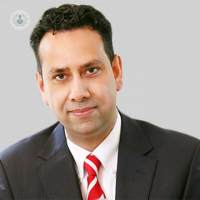Laser disc surgery – a new treatment for slipped disc
Written by:A small number of clinics in the UK now offer a brand new procedure called laser disc surgery to treat slipped disc, promising a faster recovery and minimal risks. We spoke to Mr Mo Akmal, one of London’s leading orthopaedic spinal surgeons, about how the procedure works and what else it can be used for.

How does laser disc surgery work?
Laser disc surgery is performed under local anaesthetic and mild sedation without the need for a skin incision. The procedure takes approximately 15 minutes, and the patient can mobilise shortly after the procedure and return to work on the following day.
A needle is inserted into the affected disc using X-ray in the operating theatre. A sophisticated laser probe is then inserted through the needle and laser tip is positioned into the soft part of the disc. The laser probe delivers energy into the disc and vaporises a small portion of the disc. The remaining disc then shrinks into the cavity created by the laser probe thereby reducing pressure on nerves or spinal cord.
Laser disc surgery is approved by the National Institute of Clinical Excellence (NICE).
What are the advantages of the procedure?
The procedure is suitable for disc bulges affecting the cervical or lumbar spine.
The benefits of laser disc surgery include:
- rapid recovery
- no skin incision
- very short treatment time
- good results with minimal risks.
What are the risks and side effects?
It is rare to suffer any complications because the procedure is fully performed under live X-ray and creates no muscle or bone damage. Complications can rarely include temporary numbness or weakness or injury caused by incorrect laser application. This is why the procedure can only be performed by surgeons trained in the use of lasers for spinal surgery and in an operating theatre customised for the use of laser devices.
This procedure is also suitable for elderly patients and patients with complicated medical problems – where general anaesthetic or prolonged surgery are not indicated.
What can the procedure be used for?
Laser disc surgery (PLDD) can be used for the treatment of:
- slipped discs that are difficult to access by traditional methods such as microdiscetomy.
- spinal stenosis
- nerve pain referring into the legs or arms.
- foraminal stenosis
- radiculopathy
If you would like to book a consultation with Mr Akmal and discuss the possibility of laser disc surgery, click here.



